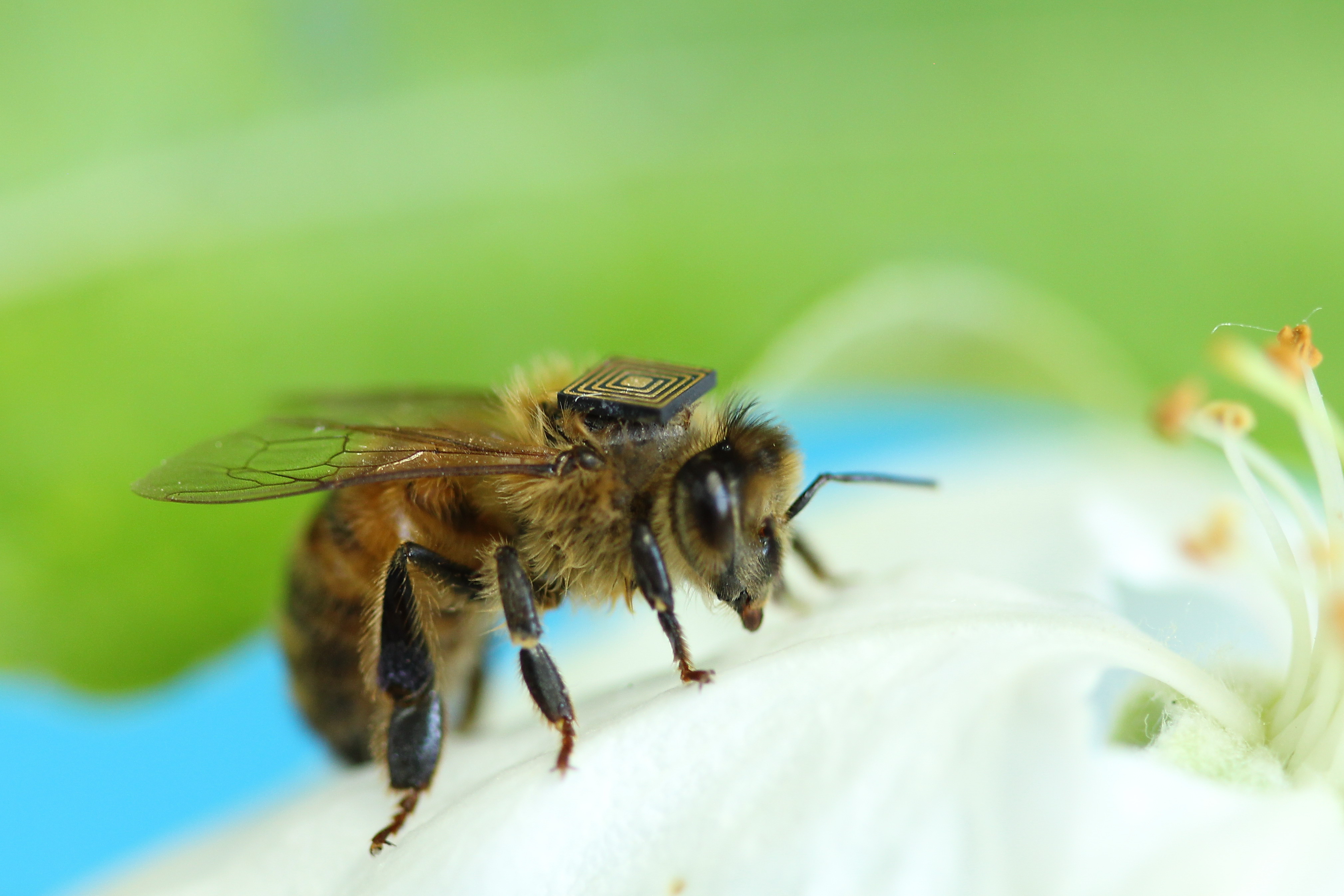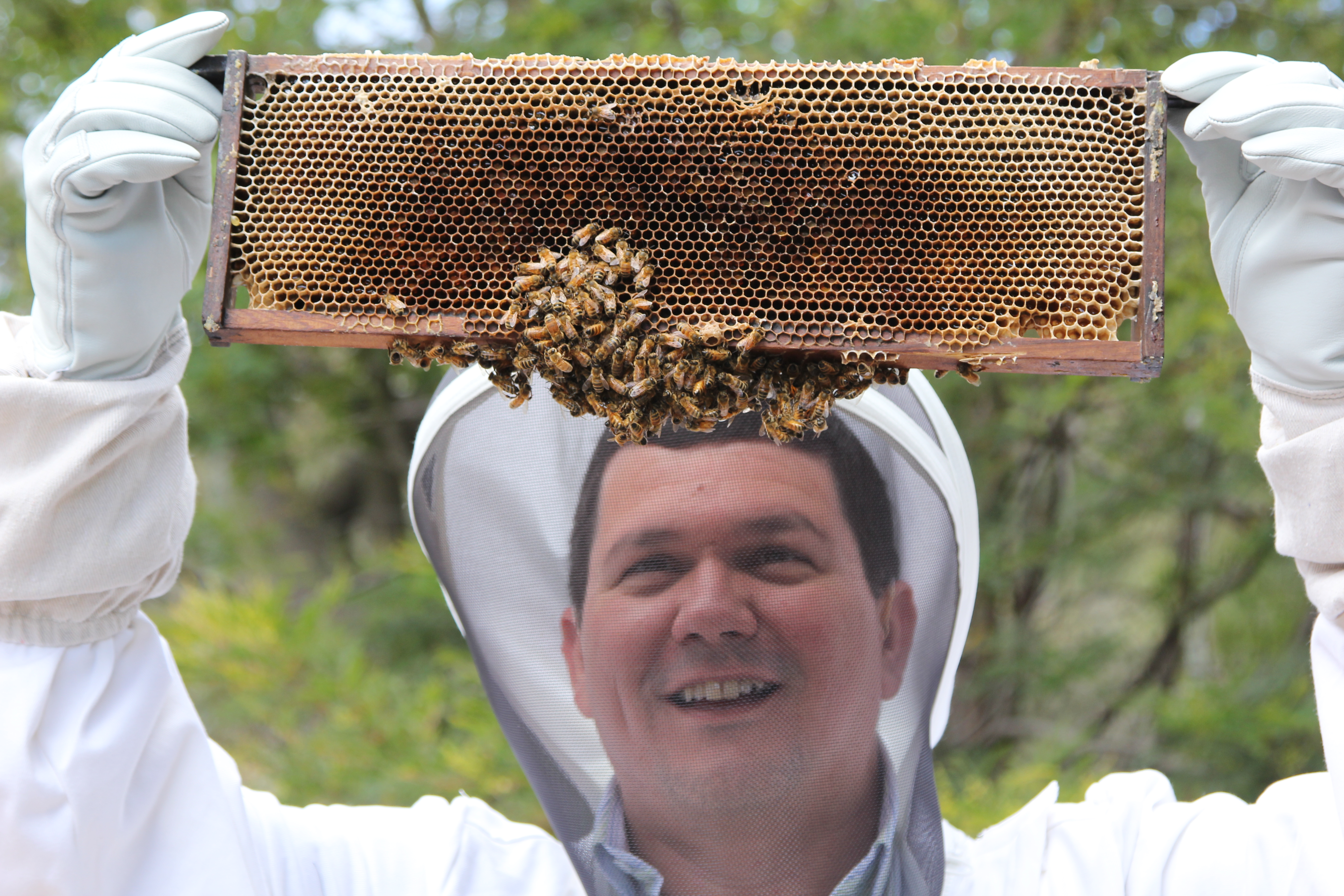
Bee with a backpack… of the sensor variety.
What if I told you that insects in the environment may be able to tell us about the world they live in? Imagine it; they could reveal changes in climate, the presence of dangerous gases or even the arrival of pests. Now you might think this a flight of fancy and tell me to buzz off, but this may not be so far from reality.
Our new research project is using tiny sensors that act like your car’s e-tag and attaching them to the backs of honey bees.
What the?
You heard right – bees with a chip on their shoulder, or on their back at least.
These tiny 2.5mm x 2.5mm chips relay data to recorders placed around hives and known food sources. We’re not talking about one or two wired up insects here, 5,000 tags are currently being attached to honey bees in Hobart and released into the natural environment.
And why would our researchers do that?
Collecting bee movement information at this scale is a world first and will allow researchers to generate a four dimensional model (three dimensions over time) of bee behaviour and the way these insects move through the landscape. This information is needed on a global scale as wild honey bee populations are dropping drastically or vanishing all together. In some instances this is because of the parasitic Varroa mite. In others it’s a case of Colony Collapse Disorder, which is believed to be caused by diseases and agricultural pesticides.
CSIRO’s Dr Paulo de Souza leads the project and talks about why it is so important to protect these often feared insects. He says:
Honey bees play an extremely important role in our daily lives. Around one third of the food we eat relies on pollination and this is a free service these insects provide. A recent CSIRO study showed that honey bees helped increase faba bean yield by up to 17 per cent. Knowing how bees interact with their environment will allow farmers, fruit growers and seed producers to manage their properties using honey bees to increase productivity.

Dr Paulo with his beloved bees.
The research is also looking at the impacts of farm pesticides on honey bees and how much these chemicals contribute to CCD. Healthy bees means healthy landscapes.
Tagging the bees is only the first stage in the project. The next requires us to make the sensors even smaller, down to the size of a grain of sand so they can be used on smaller insects like mosquitoes and fruit flies.
“We also want these smaller tags to be able to sense environmental conditions such as temperature and presence of atmospheric gases; not just track their location.”
“Further to this the sensors will be able to generate energy from the beating wings of the insects, which will give the sensors enough power to transmit information instead of just storing it until they reach a data logger,” says Dr De Souza.
In short, insects will be real-time ‘swarm sensing’ at a scale never before achieved. Insects could become the canaries of the mines or the sniffer dogs of the airports. Bring on the buzz.
Media: Emma Pyers, +61 3 5227 5123, emma.pyers (at) csiro.au


6th February 2014 at 6:12 pm
Steph,
One thought has come to mind recently, with the data that you collect are you able to tell if the plants the bees go to are GM. Example Gum tree on the east coast. This is truly something that has to be incorporated into the equation. As is plantation farming. You may have this covered already however. Though I feel these are questions that need to be looked at also. Thank you
Regards
Sandra Kenny
7th February 2014 at 11:23 am
Hi Sandra,
The tags simply record certain checkpoints in the landscape where we’ve placed data loggers. The bee has to pass by within a certain proximity to these loggers to record its location. These are places of known food sources, typically within about 700 metres of their hive, but future versions will be able to monitor constant movements through the landscape instead of checkpoints.
Hope that helps!
Cheers,
Steph
7th February 2014 at 2:26 pm
Thanks Steph, can see there is hugh protensul
with these tags. Once again so happy you are doing this, making a start in research, and taking a stand. 100% behind you and the zillion bees we need to survive.
5th February 2014 at 1:50 pm
Well done.
Thank You.
I’m so happy to know some one has taking such interest in what is happening to our bees. If there is nothing done what will happen in the long run will be so devastating. We are doing our little bit, by planting many flowers natural or from an organic seed saver even our own seeds. We don’t use pesticides or herbicides nothing. What else is there that I can do to help these wonderful creatures who give us so much. I am unable to have a hive because we are suburbia however. Thank you for doing this I’m sure your research will enlighten many of us.
Regards
Sandra Kenny
4th February 2014 at 3:33 pm
Considering the short life of a honey bee in summer, there will be a great ‘loss’ of tags. Is the study on-going? Will the tagging be repeated on new bees?
6th February 2014 at 9:40 am
Hi Robert,
The bees in Tassie are very active until early May. After May, we’ll stop the field work for a month or so while we analyse the data. When they do eventually perish, the tags will be lost but we can get these tags for about 40 cents each so the loss isn’t significant in terms of expense or data as we’ll already have the information.
The study will certainly continue in Tasmania and the mainland and we plan to launch a global study in the near future.
Cheers,
Steph
23rd July 2014 at 3:22 am
Steph,
Can you share your tag supplier?
Thanks!
4th February 2014 at 3:19 pm
Wow. Exciting stuff. But not sure that bees can be directed or taught where to fly and/or to return to base by a given time, let alone not to sting people. So speculation about bees replacing canaries in mines and /or sniffer dogs at airports may be a bit over the top. But I love my bees and honey so very pleased to support this project.
4th February 2014 at 2:32 pm
Great to see the sensor technology being used to monitor bees and new tags planned for a range of applications including the sensing of environmental conditions. The current bee sensor is a square shape but this could affect bee aerodynamics. Has sensor shape been considered in relation to aerodynamic drag and is it possible to take this into account?
5th February 2014 at 1:52 pm
Is it not possible to have these sensors circular.?
6th February 2014 at 9:32 am
Hi Liz and Sandra,
The current tags being used are existing technology which we haven’t adapted or changed, just purchased. We’re simply testing the technical capability first. The next phase will certainly look at how to improve this existing technology both in terms of technical performance as well as physical size and shape. The aim is to reduce the size of the tag to 1mm x 1mm or less (currently 2.5mm x 2.5mm) to help reduce any potential drag. The suggestion of a more appropriate shape is also a good one and will be considered.
Cheers,
Steph
6th February 2014 at 6:07 pm
Thank you for your up date, it sounds wonderful, at least it’s a start, step, flight in the right direction. With out these little creatures we are in serious trouble.